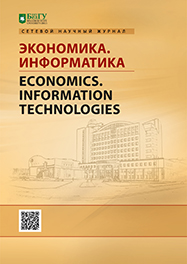CONCEPTUAL MODEL OF INFOCOMMUNICATION SYSTEMS FOR COLLECTING AND ANALYZING DATA ON THE HEALTH STATUS OF THE POPULATION
The study was carried out with the financial support of the Russian Foundation for Basic (projectы № 18-07-00380, № 19-07-00832, by the state research 0073–2019–0004, partial financial support of the Government of the Russian Federation (grant 08-08).
DOI:
https://doi.org/10.18413/2687-0932-2020-47-1-164-175Keywords:
modeling of information communication systems for medical purposes, collection and analysis of statistical medical data, public health monitoring, health system performanceAbstract
The article analyzes the main trends in the development of modern information and communication systems for medical purposes in Russia and abroad. It is concluded that the tasks of creating, developing and improving such systems are currently of particular relevance. The analysis of the features of the implementation and practical application of information and communication systems designed for the collection and analysis of medical data in Russia. The main functions of information and communication systems intended for collecting and analyzing medical statistics have been identified and systematized. A conceptual model of a generalized information and communication system for the col-lection and analysis of statistical medical data is presented. An embodiment of a typical information and communication system designed for collecting and analyzing data on the health status of the population has been proposed, the purpose of the main elements included in its composition, as well as the main stages of its work are described; presents suggestions for its practical application. The paper highlights the main advantages and disadvantages of modern information and telecommunication systems designed to collect and analyze medical information, and also dis-cusses possible promising areas for further improvement and work on this topic. It was concluded that the use of the models described in the work (their use in the implementation of information and communication systems designed to collect and analyze data on the health status of the population) will improve both the performance of individual medical institutions and the efficiency of the Russian health system as a whole. At the same time, it is expected that further development of solutions for the integration of medical information and communication systems will improve the quality of management of the work of various healthcare institutions and organizations, as well as improve the efficiency of medical services for Russian citizens.
Downloads
References
1984. Доктрина информационной безопасности РФ. Указ Президента РФ от 05.12.2016 № 646–2016. М.: Машиностроение. 288 с.
Винокурова М.А. 2018. Телемедицина: баланс безопасности и эффективности? Вестник Нижегородского университета им. Н.И. Лобачевского. 3: 89–96.
Государственная программа развития здравоохранения Российской Федерации. URL: http://pravo.gov.ru/proxy/ips/?docbody=&nd=102349622 (дата обращения: 29.04.2019).
Гуров А.Н., Огнева. Е.Ю., Плутницкий А.Н., Давронов И.В. 2018. Применение программного комплекса для анализа эффективности нового менеджмента в работе поликлиник и выявления причин неудовлетворенности пациентов первичной медико-санитарной помощью. Врач и информационные технологии. 10: 6–7.
Зарубина Т.В. 2016. Единая государственная информационная система здравоохранения: вчера, сегодня, завтра. Сибирский вестник медицинской информатики и информатизации здравоохранения. 1: 6–11.
Карпов О.Э., Субботин С.А., Шишканов Д.В., Замятин М.Н. 2017. Цифровое здравоохранение. Необходимость и предпосылки. Врач и информационные технологии. 3: 6–22.
Концепция информатизации здравоохранения России. URL: http://www.ingzdrav.ru/_dr/ 0/19_ZRJ.pdf (дата обращения: 29.04.2019).
Концепция развития здравоохранения Российской Федерации до 2020. URL: http://federalbook.ru/files/FSZ/soderghanie/Tom%2012/1-9.pdf (дата обращения: 29.04.2019.
Копаница Г.Д. 2017. Обработка и передача данных медицинской статистики на основе международного стандарта ISO 13606. Бюллетень сибирской медицины. 13(4): 53–57.
Лемешко В.А., Тепцова Т.С. 2017. Телемедицина: здравоохранение делает шаг в будущее. Медицинские технологии: оценка и выбор. 4: 30–38.
Мотиенко А.И., Басов О.О. 2015. Вероятностная модель положения транспортировки пострадавшего. Сборник трудов 7-й Всероссийской научно-практической конференции по имитационному моделированию и его применению в науке и промышленности «Имитационное моделирование. Теория и практика» (ИММОД-2015). 230–235.
Мотиенко А.И. 2017. Предпосылки создания инфокоммуникационной системы мониторинга состояния здоровья населения. Научный результат. 2(3): 24–30.
Федеральный закон от 29.07.2017 № 242-ФЗ «О внесении изменений в отдельные законодательные акты РФ по вопросам применения информационных технологий в сфере охраны здоровья». URL: http://publication.pravo.gov.ru/Document/View/0001201707300032 (дата обращения: 29.04.2019).
Шадов С.С., Чиповская И.С. 2013. К вопросу об эффективности информационных технологий на российском рынке медицинских услуг. Вестник Владивостокского государственного университета экономики и сервиса. 3: 239–246.
Manu-Marin A., Center E.P.R. 2015. Telemedicine as an Alternative Model for Delivering Healthcare Services: Preliminary Results of the MultiMED Project. Modern Medicine. 22(4): 342–345.
Abstract views: 760
Share
Published
How to Cite
Issue
Section
Copyright (c) 2020 ECONOMICS. INFORMATION TECHNOLOGIES

This work is licensed under a Creative Commons Attribution 4.0 International License.


